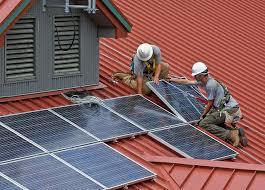“American taxpayers spent an average of $39 billion a year over the past five years financing grants, subsidizing tax credits, guaranteeing loans, bailing out failed solar energy boondoggles and otherwise underwriting every idea under the sun to make solar energy cheaper and more popular. But none of it has worked.”
In the United States, by mid-2016, the Big Three politically correct renewable energy sources wind power surpassed 75 Gigawatts, solar power surpassed 27 Gigawatts, and biofuels surpassed 16 billion gallons per year (mostly ethanol from corn).
In the article “Obama Legacy Will Be Power Blackouts” June 6, 2016, Professor Larry Bell wrote:
If you have heard some really exciting news that the Obama administration has already doubled the amount of total U.S. energy derived from ‘renewable alternative’ sources (solar, wind and biofuels), that would be true. Thanks largely to $150 billion in generous federal subsidies, combined total renewables grew from supplying slightly more than 2 percent of our ‘primary fuel’ (including electricity) to a whopping 4 percent today.
Solar Energy: Subsidies Required
There are many disadvantages to solar energy because it is unavailable most of the day—availability is expressed as capacity factor defined as the fraction of total annual solar energy produced compared to a facility operating 24-hours daily, 365 days per year. Capacity factors of solar plants in Southwest desert areas are 0.19 compared to capacity factors of 0.9 or greater for nuclear and fossil-fueled electricity plants.
Other disadvantages are solar plants require vast land areas when used for utility-scale power generation (6 acres per Megawatt) and have limited useful plant lifespans of about 25 years. Nuclear and fossil-fueled power plants have small land requirements (less than one square mile for 1000 Megawatts) and lifespans of 60 years or more.
Solar electricity is more expensive than conventional electricity from fossil fuels of coal and natural gas. Subsidies are required to promote its use in the form of payments or tax credits for construction of solar systems, rapid depreciation of solar systems, forcing power companies to pay above market prices for excessive electricity production called feed-in-tariffs, mandates for use of solar energy without regard to cost, and a host of other subsidies.
The vast array of subsidies is provided by the U. S. government, state governments, and municipalities.
Subsidies for individual states and municipalities are given by aDepartment of Energy website operated by North Carolina State University “Database of State Incentives for Renewables & Efficiency”.
A report from The Taxpayers Protection Alliance “Filling the Solar Sinkhole” said, “American taxpayers spent an average of $39 billion a year over the past 5 years financing grants, subsidizing tax credits, guaranteeing loans, bailing out failed solar energy boondoggles and otherwise underwriting every idea under the sun to make solar energy cheaper and more popular. But none of it has worked.”
‘Secret Dirty War’ to Stop Solar?
In spite of all the subsidies, promoters of solar energy complain they are treated unfairly in what they claim to be a competitive electricity production market. Author, radio broadcaster, and liberal jack-of-all-trades communicator Thom Hartmann produced two YouTube shows on solar energy carried on RT television. RT television, originally Russia Today, has been accused “of broadcasting ‘materially misleading’ content'”.
The first of the six-minute videos called “The Secret Dirty War To Stop Solar Power” is an interview between Thom Hartmann and Brendan Fischer, General Counsel, Center for Media and Democracy. They claimed the Koch brothers, Walton family, and American Legislative Exchange Council (ALEC) is trying to stop implementation of roof-top solar for residences. ALEC is a nonprofit organization of conservativestate legislators and private sector representatives that drafts and shares model state-level legislation.
The Koch brother’s opposition to solar energy is supposedly due to their owning oil interests. But oil is used for transportation and chemicals and less than 1 percent of the nation’s electricity is generated with oil—principally in Hawaii.
Further disparaging remarks about the Koch brothers are given by New York Times writer Paul Krugman, “Meanwhile, buying politicians is a pretty good business for fossil-fuel magnates like the Koch brothers.” It would be interesting to compare philanthropic activities of the Koch brothers with their liberal critics.
The Walton family is said to oppose roof-top solar because it competes with utility-scale solar energy. The Walton family owns First Solar, which makes solar panels for utility solar facilities and builds commercial solar facilities.
ALEC is claimed to oppose roof-top solar because it helps state legislators or Public Service Commission’s craft rules to insure fairness for electricity customers. ALEC opposes net metering—the feed-in-tariff that forces utilities to reimburse solar electricity producers the full utility-produced retail price for solar electricity returned to the grid.
A summation of the six-minute video is its total baloney. Net metering is having utilities pay solar customers the full retail price for excess solar electricity returned to the grid. Yet this price, a huge subsidy that the utility (really other customers) must pay to the generally more affluent solar early adopters.
The U.S. average residential price for electricity is about 12 cents per kilowatt-hour. However, it costs utilities about 4–5 cents per kilowatt-hour to produce electricity at their power stations. The rest of consumer’s costs are profit (maybe one cent per kilowatt-hour), cost of billing, and cost of constructing and maintaining distribution systems (transmission lines).
Hidden Subsidies
Utilities pay the costs of restoring power when wind, ice, and snow storms knock down utility lines. These costs are more than 5 cents per kilowatt-hour.
Roof-top solar generates most of its electricity from 9 a.m. to 5 p.m.with a maximum output around noon. These are times when residential use is smaller because residential occupants are at work or school. Thus the amount of solar electricity returned to the grid for net metering is large. In addition, utilities lose all the income from electricity produced by roof-top solar systems.
Therefore, net metering and residential solar use takes away needed operating income from utilities and forces non-solar customers to make up that loss through higher electric bills.
An analogy would be for states to reimburse bicycle riders with gas tax money used to build and maintain road structures for every mile they use their bicycles. Riding bicycles replaces driving cars that damage road surfaces. Due to loss of gas tax revenue given bicycle riders, states have to raise gas taxes for auto owners to make up lost revenue.
Net metering is totally unfair to electricity users. This is one of many subsidies by governments paying residential users of solar energy. Another subsidy is a 30 percent federal tax credit for the cost of building solar systems. The annual loss of income for the federal government is many billions per year. This is for a government going into debt at the rate of $1.5 billion per day.
Other subsidies are paid out by some states in the form of tax credits. Georgia used to have a pay back of 35 percent. Additional subsidies may be in the form of depreciation deductions on state and federal taxes. Another form of subsidy is mandates from states a certain fraction of electricity generation has to come from solar energy.
Solar Battle Royale
“The Solar Power Battle Now Being Fought” features a discussion of solar power in Hawaii between Thom Hartmann and Adam Browning, Co-founder and Executive Director of Vote Solar. Hawaii has the highest solar electricity penetration in the U. S. with 12 percent of their residences having roof-top solar. The U. S. Energy Information Administration reports Hawaii produced 4.84 percent of their electricity from solar for March 2016; the highest in the nation.
Hawaii has the highest priced electricity in the U. S. with a residential rate for March 2016 of 27.35 cents per kilowatt-hour. This makes residential roof-top solar very attractive from an economic point of view; especially with net metering.
Note: Along with the highest electricity prices in the U. S.,Hawaii has high gasoline prices with Honolulu averaging $2.54 a gallon June 13, 2016 versus the national average of $2.38. These high prices are due to oil being Hawaii’s main source of energy. Natural gas can be substituted for oil in both electricity production and transportation with considerable savings in prices. Liquefied natural gas (LNG) is shipped to Hawaii as a substitute for oil. Compressed natural gas (CNG) used for vehicles has an energy density about one-third gasoline which limits vehicle range to under 190 miles. For the small distances traveled in Hawaii, CNG poses no problem. Energy savings using LNG in Hawaii also apply to near bankrupt Puerto Rico.
Adam Browning claimed utilities in Hawaii are discouraging additional residential use of roof-top solar. Hawaii has net metering. Thom Hartmann responded high penetration of solar energy has taken place in Germany with no problems. (He forgot to mention Germany has residential electricity rates close to triple that in the U. S. and on occasion Germany has to unload excess electricity production on its neighboring countries.)
Hartmann then mentioned half the electricity in the U. S. is produced by for-profit utilities and the other half by non-profit municipal co-ops or electric membership corporations (EMC). Electricity in Hawaii is produced by for-profit utilities. He speculated non-profit utilities would be delighted to have additional roof-top solar implemented by the residential sector. Adam Browning thought this was a great idea and heartily agreed with him. They thought cities in Hawaii should form co-ops.
Neither speaker was astute enough to recognize net metering, as well as solar electricity used, takes away income for utility operating expenses that has to be produced in some fashion. The only way out of this problem is to increase electricity rates for all users. Once again non-solar users pay higher electricity rates to subsidize roof-top solar producers.
Final Comment
Solar energy exists only because of the multitude of subsidies produced by federal and state governments. It is essentially a new 21st century electricity source. The lifetime of solar panels is about 25 years and they become junk that will require disposal of toxic materials. This will be a future loss for tax payers.
[Originally published at Master Resource]
James H. Rust, professor of nuclear engineering and policy advisor to The Heartland Institute. Since 1992, Prof. Rust has endowed over 50 scholarships for students studying engineering





